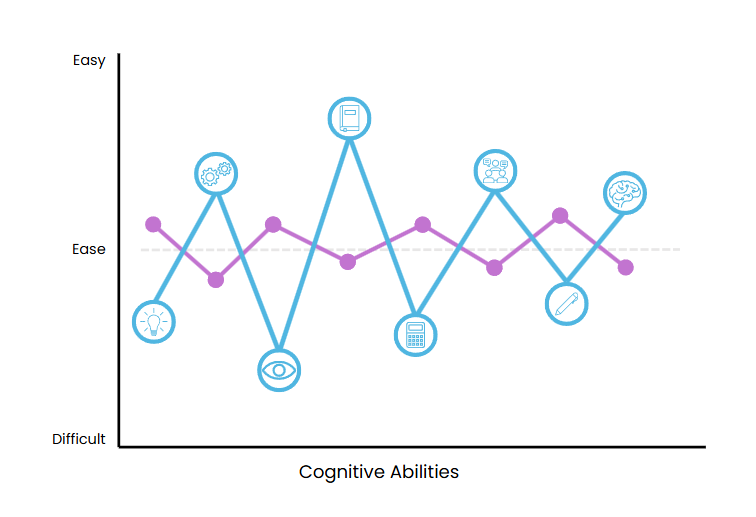Spiky profiles: rethinking strengths and challenges
Have you heard of spiky profiles?
When working with people who are newly diagnosed or who don’t yet have a diagnosis, I often find they haven’t come across this concept before. Yet, spiky profiles are a fantastic way to understand the cognitive differences associated with neurodivergence.
When someone receives a diagnosis but isn't given much information about it – or about neurodiversity in general – I find that introducing spiky profiles during coaching sessions can be really helpful.
A spiky profile
🔹The purple line in the diagram above represents a neurotypical cognitive profile. There are areas this person find easier and areas they find harder, but overall, the differences are relatively small.
🔹The blue spiky line shows a neurodivergent profile. Here too, there are strengths and challenges, but the gaps between the two are much bigger.
In the workplace, this means a neurodivergent person might excel at certain tasks and perform them far better than their peers, but they might also find other tasks significantly more challenging.
This can have an impact as there are often one-size-fits-all expectations around productivity.
While it’s important to find strategies to manage the tougher areas, it’s equally important to recognise and celebrate your strengths. Many people get so used to focusing on the difficulties, especially if these have been pointed out to them over the years, that they forget just how capable they are in other areas.
Coaching can be a really effective way to identify your strengths and develop strategies to handle challenges. It also offers a safe, non-judgemental space to explore what works best for you.
Removing barriers
And it’s not just your strengths to consider. There may be barriers in the workplace that prevent you from doing your best work.
Sometimes the key to thriving isn’t about ‘fixing’ the difficult areas, but instead removing the friction that makes them harder than they need to be. This might mean changing the environment, adjusting how information is communicated or negotiating different ways of working.
Reasonable adjustments don’t have to be complicated or costly – sometimes small tweaks can make the biggest difference.
Reframing strengths
It can also be empowering to reframe strengths that have previously been overlooked or misunderstood. For example, someone who has been told they’re ‘too detail-focused’ might actually have an incredible ability to spot errors or patterns others miss. A person who finds it hard to follow a fast-paced meeting might shine when given time to reflect and respond in writing.
Start by noticing when and where you feel most engaged, energised and able to focus. Those moments often point to environments that support your strengths. From there, consider what might help you create more of those conditions, either independently or through conversations with your manager or HR.
Spiky profiles are a reminder that uneven ability isn’t a flaw. Recognising this helps shift the focus from fitting in to finding alignment between your unique cognitive profile and the way you work. And when that happens, the results can be transformative – not just for individuals, but for teams and organisations too.

